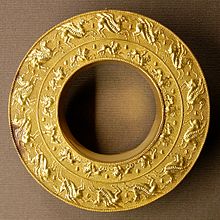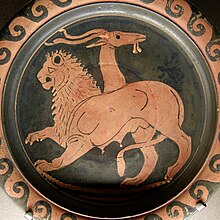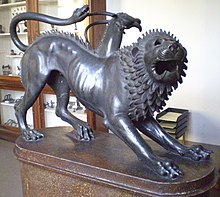Chimera (mythology)
From Wikipedia, the free encyclopedia
For other uses of the term "Chimera", see Chimera (disambiguation).
The Chimera (also Chimaera or Chimæra) (pron.: /kɨˈmɪərə/ or /kaɪˈmɪərə/; Greek: Χίμαιρα, Khimaira, from χίμαρος, khimaros, "she-goat") was, according to Greek mythology, a monstrous fire-breathing female creature of Lycia in Asia Minor, composed of the parts of three animals: a lion, a serpent and a goat. Usually depicted as a lion, with the head of a goat arising from its back, and a tail that ended in a snake's head,[1] the Chimera was one of the offspring of Typhon and Echidna and a sibling of such monsters as Cerberus and the Lernaean Hydra. The term chimera has come to describe any mythical or fictional animal with parts taken from various animals.
Contents |
Description
Homer's brief description in the Iliad[2] is the earliest surviving literary reference: "a thing of immortal make, not human, lion-fronted and snake behind, a goat in the middle,[3] and snorting out the breath of the terrible flame of bright fire".[4] Elsewhere in the Iliad, Homer attributes the rearing of Chimera to Amisodorus.[5] Hesiod's Theogony follows the Homeric description: he makes the Chimera the issue of Echidna: "She was the mother of Chimaera who breathed raging fire, a creature fearful, great, swift-footed and strong, who had three heads, one of a grim-eyed lion; in her hinderpart, a dragon; and in her middle, a goat, breathing forth a fearful blast of blazing fire. Her did Pegasus and noble Bellerophon slay"[6] The author of the Bibliotheca concurs:[7] descriptions agree that she breathed fire. The Chimera is generally considered to have been female (see the quotation from Hesiod above) despite the mane adorning its lion's head, the inclusion of a close mane often was depicted on lionesses, but the ears always were visible (that does not occur with depictions of male lions). Sighting the Chimera was an omen of storms, shipwrecks, and natural disasters (particularly volcanoes).While there are different genealogies, in one version the Chimera mated with her brother Orthrus and mothered the Sphinx and the Nemean lion (others have Orthrus and their mother, Echidna, mating; most attribute all to Typhon and Echidna).
The Chimera finally was defeated by Bellerophon, with the help of Pegasus, at the command of King Iobates of Lycia. Since Pegasus could fly, Bellerophon shot the Chimera from the air, safe from her heads and breath.[8] A scholiast to Homer adds that he finished her off by equipping his spear with a lump of lead that melted when exposed to the Chimera's fiery breath and consequently killed her, an image drawn from metalworking.[9]

Gold reel, possibly an ear-stud, with winged Pegasus (outer band) and the Chimera (inner band), Magna Graecia or Etruria, fourth century BC (Louvre)
In Etruscan civilization, the Chimera appears in the "Orientalizing" period that precedes Etruscan Archaic art; that is to say, very early indeed. The Chimera appears in Etruscan wall-paintings of the fourth century BC.

Pebble mosaic depicting Bellerophon killing the Chimera, from Rhodes archaeological museum
In Medieval art, though the Chimera of Antiquity was forgotten, chimerical figures appear as embodiments of the deceptive, even Satanic forces of raw nature. Provided with a human face and a scaly tail, as in Dante's vision of Geryon in Inferno xvii.7–17, 25–27, hybrid monsters, more akin to the Manticore of Pliny's Natural History (viii.90), provided iconic representations of hypocrisy and fraud well into the seventeenth century, through an emblemmatic representation in Cesare Ripa's Iconologia.[16]
Classical sources
The myths of the Chimera can be found in Pseudo-Apollodorus' Bibliotheca (book 1), Homer's Iliad (book 6); Hyginus' Fabulae 57 and 151; Ovid's Metamorphoses (book VI 339; IX 648); and Hesiod's Theogony 319ff.Virgil, in the Aeneid (book 5) employs Chimaera for the name of Gyas' gigantic ship in the ship-race, with possible allegorical significance in contemporary Roman politics.[17]
Hypothesis about origin
Main article: Mount Chimaera
Pliny the Elder cited Ctesias and quoted Photius identifying the Chimera with an area of permanent gas vents which still can be found today by hikers on the Lycian Way in southwest Turkey. Called in Turkish Yanartaş (flaming rock), it consists of some two dozen vents in the ground, grouped in two patches on the hillside above the Temple of Hephaestus about 3 km north of Çıralı, near ancient Olympos, in Lycia. The vents emit burning methane thought to be of metamorphic origin, which in ancient times were landmarks by which sailors could navigate.The Neo-Hittite Chimera from Carchemish, dated to 850–750 BC, which is now housed in the Museum of Anatolian Civilizations[18] no doubt served as a basis for the Greek legend. It differs from the Greek version in that while there are three heads, none of them is that of a goat, only a main human head, a lion's head facing forward and placed on the chest of the lion's body, and a snake's head placed at the end of the tail.
Use for Chinese mythological creatures
Some western scholars of Chinese art, starting with Victor Segalen, use the word "chimera" generically to refer to winged quadrupeds, such as bixie, tianlu, and even qilin.[19]See also
| Look up chimera in Wiktionary, the free dictionary. |
Notes
- ^ Peck, "Chimaera".
- ^ Homer, Iliad 6.179–182
- ^ "The creature was a goat; a young goat that had seen but one winter was called chimaira in Greek". (Kerenyi 1959:82).
- ^ In Richmond Lattimore's translation.
- ^ Homer, Iliad, 16.328–329
- ^ Hesiod Theogony 319–325 in Hugh Evelyn-White's translation.
- ^ Pseudo-Apollodorus, Bibliotheca 2.3.1: "it had the fore part of a lion, the tail of a dragon, and its third head, the middle one, was rough which it belched fire. And it devastated the country and harried the cattle; for it was a single creature with the power of three beasts. It is said, too, that this Chimera was bred by Amisodarus, as Homer also affirms,3 and that it was begotten by Typhon on Echidna, as Hesiod relates".
- ^ Pindar: Olympian Odes, 13.84–90; Pseudo-Apollodorus, Bibliotheca 2.3.2; Hesiod, Theogony 319 ff.
- ^ Graves, section 75, note
- ^ Homer, Iliad 16.328–329, links her breeding to the Trojan ally Amisodarus of Lycia, as a plague for men.
- ^ Anne Roes "The Representation of the Chimaera" The Journal of Hellenic Studies 54.1 (1934), pp. 21–25, adduces Ancient Near Eastern conventions of winged animals who wings end in animal heads.
- ^ This outline of Chimera motifs follows Marilyn Low Schmitt, "Bellerophon and the Chimaera in Archaic Greek Art" American Journal of Archaeology 70.4 (October 1966), pp. 341–347.
- ^ Later coins struck at Sicyon, near Corinth, bear the chimera-motif. (Schmitt 1966:344 note.
- ^ Schmitt 1966.
- ^ Graves 1960:sect.34.2.
- ^ John F. Moffitt, "An Exemplary Humanist Hybrid: Vasari's 'Fraude' with Reference to Bronzino's 'Sphinx'" Renaissance Quarterly 49.2 (Summer 1996), pp. 303–333, traces the chimeric image of Fraud backwards from Bronzino.
- ^ W.S.M. Nicoll, "Chasing Chimaeras" The Classical Quarterly New Series, 35.1 (1985), pp. 134–139.
- ^ fr:Fichier:Museum of Anatolian Civilizations080.jpg
- ^ Barry Till (1980), "Some Observations on Stone Winged Chimeras at Ancient Chinese Tomb Sites", Artibus Asiae 42 (4): 261–281, JSTOR 3250032
References
- Graves, Robert, (1955) 1960. The Greek Myths (Baltimore: Penguin), section 75.b, pp 252–56
- Kerenyi, Karl, 1959. The Heroes of the Greeks. (London and New York:Thames and Hudson)
- Peck, Harry Thurston, 1898. Harpers Dictionary of Classical Antiquities: "Chimaera"
Research Reference for Monstropedia Everna
Source: http://en.wikipedia.org/wiki/Chimera_%28mythology%29
















No comments:
Post a Comment